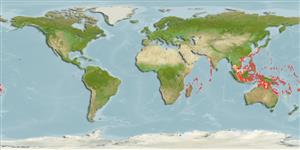Echinoidea |
Camarodonta |
Echinometridae
Environment: milieu / climate zone / تغييرات عمق / distribution range
بوم شناسي
; تغييرات عمق 0 - 50 m (مرجع 81020). Tropical
Indo-Pacific.
Length at first maturity / Size / Weight / سن
بلوغ: Lm ? range ? - ? cm
It is a burrowing urchin. Adapted to suspension feeding, using its long aboral spines to capture drfiting algae and suspended particulates (Refs. 125618, 129602). Associated with coral communities (Ref. 129602).
Life cycle and mating behavior
بلوغ | تولید مثل | تخم ریزی | Eggs | Fecundity | Larvae
Members of the class Echinoidea are gonochoric. Fertilization is external. Brooding is common, eggs are held either on the peristome, around the periproct or deep into the concavities on the petaloids. Life cycle: Embryos develop into planktotrophic larvae (echinoplateus) and live for several months before they sink to the bottom using their tube feet to adhere on the ground where they metamorphose into young urchins.
مآخذ اصلی
مراجع | هماهنگ كننده | همكاران
de Beer, M. 1990 Distribution patterns of regular sea urchins (Echinodermata: Echinoidea) across the Spermonde Shelf, SW Sulawesi (Indonesia). In pp. 165-174 De Ridder, C., Dubois, P., Layahe, M. C. and Jangoux, M. (eds.). Echinoderm Research. Balkema, Rotterdam. (مرجع 81254)
وضعيت در فهرست قرمز IUCN
(مرجع 130435: Version 2025-1)
وضعيت از نظر سايتس (مرجع 108899)
Not Evaluated
Not Evaluated
خطر برای انسان ها
Harmless
استفاده انسانی
| FishSource |
ابزارها
اطلاعات بيشتر
Population dynamicsرشد
Max. ages / sizes
Length-weight rel.
Length-length rel.
نوسانات طولی
Mass conversion
فراواني
Life cycleتولید مثلبلوغFecundityتخم ریزیEggsنمو تخمLarvae PhysiologyOxygen consumption
Human RelatedStamps, coins, misc.
منابع اينترنتي
Estimates based on models
Preferred temperature
(Ref.
115969): 24.6 - 28.9, mean 27.5 (based on 572 cells).
